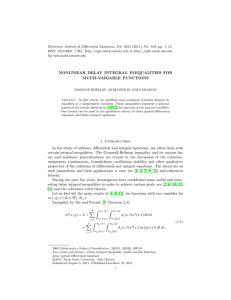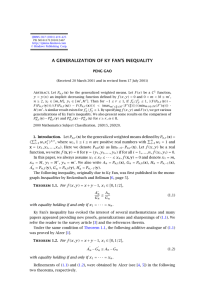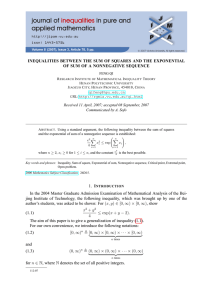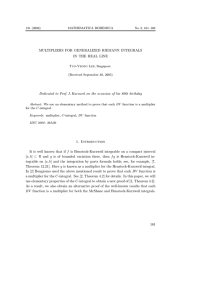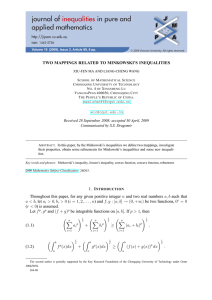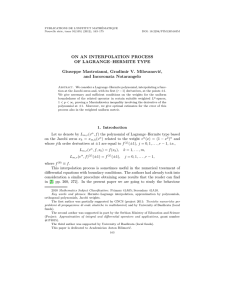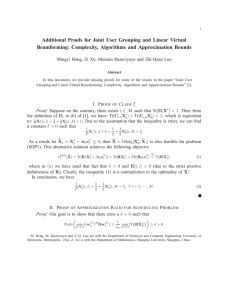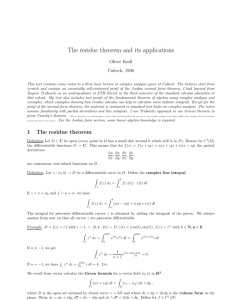Electronic Journal of Differential Equations, Vol. 2003(2003), No. 123, pp.... ISSN: 1072-6691. URL: or
advertisement
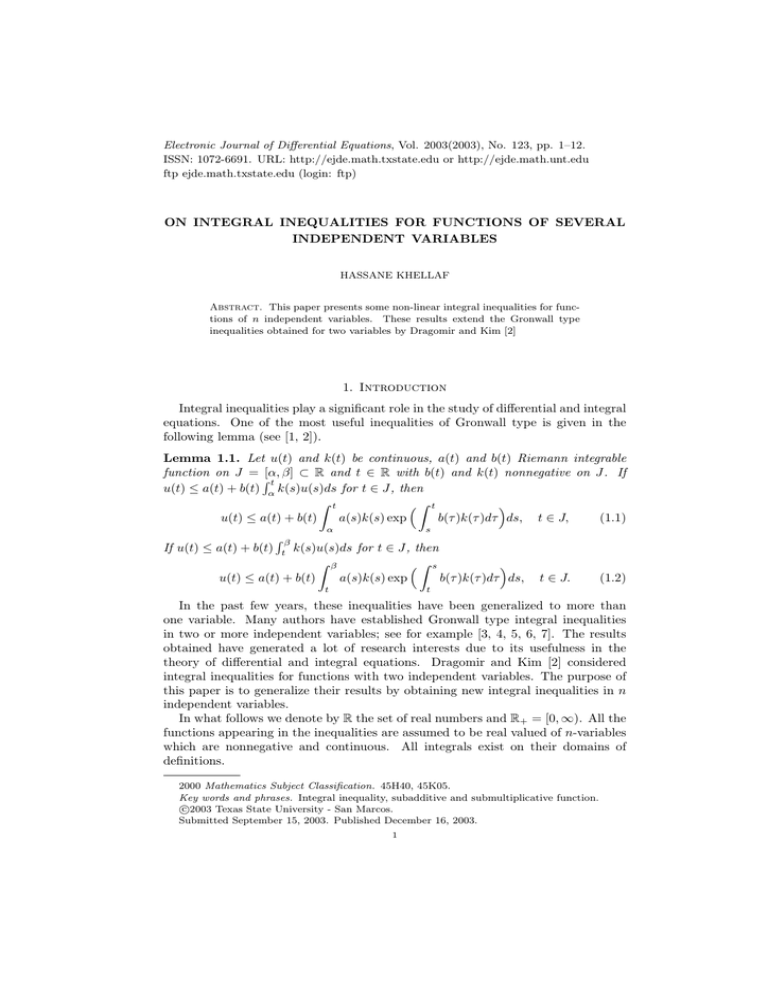
Electronic Journal of Differential Equations, Vol. 2003(2003), No. 123, pp. 1–12.
ISSN: 1072-6691. URL: http://ejde.math.txstate.edu or http://ejde.math.unt.edu
ftp ejde.math.txstate.edu (login: ftp)
ON INTEGRAL INEQUALITIES FOR FUNCTIONS OF SEVERAL
INDEPENDENT VARIABLES
HASSANE KHELLAF
Abstract. This paper presents some non-linear integral inequalities for functions of n independent variables. These results extend the Gronwall type
inequalities obtained for two variables by Dragomir and Kim [2]
1. Introduction
Integral inequalities play a significant role in the study of differential and integral
equations. One of the most useful inequalities of Gronwall type is given in the
following lemma (see [1, 2]).
Lemma 1.1. Let u(t) and k(t) be continuous, a(t) and b(t) Riemann integrable
function on J = [α, β] ⊂ R and t ∈ R with b(t) and k(t) nonnegative on J. If
Rt
u(t) ≤ a(t) + b(t) α k(s)u(s)ds for t ∈ J, then
Z t
Z t
u(t) ≤ a(t) + b(t)
a(s)k(s) exp
b(τ )k(τ )dτ ds, t ∈ J,
(1.1)
α
If u(t) ≤ a(t) + b(t)
s
Rβ
k(s)u(s)ds for t ∈ J, then
Z β
Z s
u(t) ≤ a(t) + b(t)
a(s)k(s) exp
b(τ )k(τ )dτ ds,
t
t
t ∈ J.
(1.2)
t
In the past few years, these inequalities have been generalized to more than
one variable. Many authors have established Gronwall type integral inequalities
in two or more independent variables; see for example [3, 4, 5, 6, 7]. The results
obtained have generated a lot of research interests due to its usefulness in the
theory of differential and integral equations. Dragomir and Kim [2] considered
integral inequalities for functions with two independent variables. The purpose of
this paper is to generalize their results by obtaining new integral inequalities in n
independent variables.
In what follows we denote by R the set of real numbers and R+ = [0, ∞). All the
functions appearing in the inequalities are assumed to be real valued of n-variables
which are nonnegative and continuous. All integrals exist on their domains of
definitions.
2000 Mathematics Subject Classification. 45H40, 45K05.
Key words and phrases. Integral inequality, subadditive and submultiplicative function.
c
2003
Texas State University - San Marcos.
Submitted September 15, 2003. Published December 16, 2003.
1
2
HASSANE KHELLAF
EJDE–2003/123
Throughout this paper, we shall assume that x = (x1 , x2 , . . . xn ) and x0 =
are in Rn+ . We shall denote
Z x
Z x1 Z x2
Z xn
dt =
...
. . . dtn . . . dt1
(x01 , x02 , . . . , x0n )
x0
x01
x02
x0n
∂
for i = 1, 2, . . . , n. For x, t ∈ Rn+ , we shall write t ≤ x whenever
and Di = ∂x
i
ti ≤ xi , i = 1, 2, . . . , n.
2. Results
Lemma 2.1. Let u(x), a(x) and b(x) be nonnegative continuous functions, defined
for x ∈ Rn+ .
(1) Assume that a(x) is positive, continuous function, nondecreasing in each of the
variables x ∈ Rn+ . Suppose that
Z x
b(t)u(t)dt
(2.1)
u(x) ≤ a(x) +
x0
holds for all x ∈ Rn+ with x ≥ x0 , then
u(x) ≤ a(x) exp
x
Z
b(t)dt ,
(2.2)
x0
(2) Assume that a(x) is positive, continuous function, non-increasing in each of the
variables x ∈ Rn+ . Suppose that
Z
x0
u(x) ≤ a(x) +
b(t)u(t)dt
(2.3)
x
holds for all x ∈ Rn+ with x ≤ x0 , then
u(x) ≤ a(x) exp
Z
x0
b(t)dt .
(2.4)
x
Proof. The proof of (1) is similar to the proof of (2), so we present the proof of (2)
and refer the reader to [1, p. 112] for more details.
(2) Since a(x) is positive, non-increasing in each of the variables x ∈ Rn+ , with
x ≤ x0 , then
Z x0
u(x)
u(t)
≤1+
b(t)
dt,
(2.5)
a(x)
a(t)
x
Setting
u(x)
,
a(x)
v(x) =
(2.6)
we have
x0
Z
v(x) ≤ 1 +
b(t)v(t)dt,
(2.7)
b(t)v(t)dt,
(2.8)
x
Let
Z
x0
r(x) = 1 +
x
EJDE–2003/123
INTEGRAL INEQUALITIES IN SEVERAL VARIABLES
3
Then r(x01 , x2 , . . . , xn ) = 1, and v(x) ≤ r(x), r(x) is positive and nonincreasing in
each of the variables x2 , . . . , xn ∈ R+ . Hence
Z x02 Z x03
Z x0n
D1 r(x) =
...
b(x1, t2 , . . . , tn )v(x1, t2 , . . . , tn )dtn . . . dt2
x2
Z
x02
x3
Z
xn
x03
≤
Z
x0n
b(x1, t2 , . . . , tn )r(x1, t2 , . . . , tn )dtn . . . dt2
...
x2
x3
Z
x02
Z
x03
≤ r(x)
Z
x0n
...
x2
(2.9)
xn
x3
b(x1, t2 , . . . , tn )dtn . . . dt2 ,
xn
Dividing both sides of (2.9) by r(x) we get
Z x02 Z x03
Z x0n
D1 r(x)
≤
...
b(x1, t2 , . . . , tn )dtn . . . dt2 .
r(x)
x2
x3
xn
Integrating with respect to t1 from x1 to x01 , we have
Z x0
r(x) ≤ exp
b(t)dt ,
(2.10)
(2.11)
x0
Hence
v(x) ≤ exp
x0
Z
b(t)dt .
(2.12)
x
Substituting (2.12) into (2.6), we have the result (2.4).
Theorem 2.2. Let u(x), a(x), b(x), c(x), d(x), f (x) be real-valued non-negative
continuous functions defined for x ∈ Rn+ . Let W (u(x)) be real-valued, positive,
continuous, strictly non-decreasing, subadditive, and submultiplicative function for
u(x) ≥ 0, and let H(u(x)) be real-valued, positive, continuous, and non-decreasing
function defined for x ∈ Rn+ . Assume that a(x), f (x) are nondecreasing in the first
variable x1 for x1 ∈ R+ . If
Z x1
u(x) ≤ a(x) + b(x)
c(s, x2 , . . . , xn )u(s, x2 , . . . , xn )ds
α
(2.13)
Z
x
+ f (x)H
d(t)W (u(t))dt ,
x0
Rn+
for α ≥ 0, x, t ∈
with α ≤ x1 and x0 ≤ t ≤ x, then
Z x
n
h
io
−1
u(x) ≤ p(x) a(x) + f (x)H G
G(A(t)) +
d(t)W (p(t)f (t))dt
,
(2.14)
x0
for α ≥ 0, x ∈ Rn+ with α ≤ x1 , where
Z x1
Z
p(x) = 1 + b(x)
c(s, x2 , . . . , xn ) exp
α
x1
b(τ, x2 , . . . , xn )c(τ, x2 , . . . , xn )dτ ds,
α
(2.15)
Z
∞
A(t) =
d(t)W (a(t)p(t))dt,
0
Z zx
ds
G(z) =
, z ≥ z0 > 0 .
W
(H(s))
0
z
(2.16)
(2.17)
4
HASSANE KHELLAF
EJDE–2003/123
Here G−1 is the inverse function of G and
Z ∞
Z
G
d(t)W (a(t)p(t))dt +
x0
x
d(t)W (p(t)f (t))dt,
x0
is in the domain of G−1 for x ∈ Rn+ .
Proof. Define a function
z(x) = a(x) + f (x)H
Z
x
d(t)W (u(t))dt ,
(2.18)
x0
Then (2.13) can be restated as
Z
x1
u(x) ≤ z(x) + b(x)
c(s, x2 , . . . , xn )u(s, x2 , . . . , xn )ds.
(2.19)
α
Clearly z(x) is a nonnegative and continuous in x1 ∈ R+ . x2 , x3, . . . xn ∈ R+ fixed
in (2.19) and using (1) of lemma 1.1 to (2.19), we get
Z x1
u(x) ≤ z(x) + b(x)
z(s, x2 , . . . , xn )c(s, x2 , . . . , xn )
α
Z x1
× exp
b(τ, x2 , . . . , xn )c(τ, x2 , . . . , xn )dτ ds,
α
Moreover, z(x) is nondecreasing in x1 , x1 ∈ R+ , we obtain
u(x) ≤ z(x)p(x),
(2.20)
where p(x) is defined by (2.15). From (2.18) we have
u(x) ≤ (a(x) + f (x)H(v(x))) p(x),
(2.21)
Rx
where v(x) = x0 d(t)W (u(t))dt. From (2.21), we observe that
Z x
v(x) ≤
d(t)W ((a(t) + f (t)H(v(t))) p(t)) dt
0
Zxx
Z x
≤
d(t)W (a(t)p(t))dt +
d(t)W (p(t)f (t)) W (H(v(t))) dt,
0
0
Zx∞
Zx x
≤
d(t)W (a(t)p(t))dt +
d(t)W (p(t)f (t)) W (H(v(t))) dt,
x0
(2.22)
x0
Since W is subadditive and submultiplicative
function. Define r(x) as the right
R∞
side of (2.22), then r(x10 , x2 , . . . , xn ) = x0 d(t)W (a(t)p(t))dt, v(x) ≤ r(x), r(x) is
positive nondecreasing in each of the variables x2 , . . . , xn ∈ R+ and
Z x2 Z x3
Z xn
D1 r(x) =
...
d(x1, t2 , . . . , tn )
x02
x03
x0n
× W (p(x1, t2 , . . . , tn )f (x1, t2 , . . . , tn )) W (H(v(x1, t2 , . . . , tn ))) dtn . . . dt2
Z x2 Z x3
Z xn
≤
...
d(x1, t2 , . . . , tn )
x02
x03
x0n
× W (p(x1, t2 , . . . , tn )f (x1, t2 , . . . , tn )) W (H(r(x1, t2 , . . . , tn ))) dtn . . . dt2
Z xn
Z x2 Z x3
d(x1, t2 , . . . , tn )
...
≤ W (H(r(x)))
x02
x03
x0n
× W (p(x1, t2 , . . . , tn )f (x1, t2 , . . . , tn )) dtn . . . dt2 .
(2.23)
EJDE–2003/123
INTEGRAL INEQUALITIES IN SEVERAL VARIABLES
5
Dividing both sides of (2.23) by W (H(r(x))) we get
Z x2 Z x3
Z xn
D1 r(x)
≤
...
d(x1, t2 , . . . , tn )
W (H(r(x)))
x02
x03
x0n
(2.24)
× W (p(x1, t2 , . . . , tn )f (x1, t2 , . . . , tn )) dtn . . . dt2 ,
Note that for
Z
z
G(z) =
z0
ds
,
W (H(s))
z ≥ z0 > 0
(2.25)
it follows that
D1 G(r(x)) =
D1 r(x)
,
W (H(r(x)))
(2.26)
From (2.25) , (2.26) and (2.24), we have
Z x2 Z x3
Z xn
D1 G(r(x)) ≤
...
d(x1, t2 , . . . , tn )
x02
x03
(2.27)
x0n
× W (p(x1, t2 , . . . , tn )f (x1, t2 , . . . , tn )) dtn . . . dt2 ,
Now setting x1 = s in (2.27) and then integrating with respect to x01 to x1 , we
obtain
Z x
0
G(r(x)) ≤ G(r(x1 , x2 , . . . , xn )) +
d(t)W (p(t)f (t))dt
(2.28)
x
0
R∞
Noting that r(x01 , x2 , . . . , xn ) = x0 d(t)W (a(t)p(t))dt, we have
h Z ∞
Z x
i
−1
r(x) ≤ G
G
d(t)W (a(t)p(t))dt +
d(t)W (p(t)f (t))dt .
x0
(2.29)
x0
The required inequality in (2.14) follows from the fact v(x) ≤ r(x), (2.19) and
(2.29)
Theorem 2.3. Let u(x), a(x), b(x), c(x), d(x), f (x), W (u(x)), and H(u(x)) be
as defined in theorem 2.2. Assume that a(x), f (x) are non-increasing in the first
variable x1 , for x1 ∈ R+ . If
Z β
u(x) ≤ a(x) + b(x)
c(s, x2 , . . . , xn )u(s, x2 , . . . , xn )ds
x
(2.30)
Z x10
+ f (x)H
d(t)W (u(t))dt ,
x
for β ≥ 0, x ∈ Rn+ with β ≥ x1 and x ≤ x0 . Then
Z
n
h
u(x) ≤ p(x) a(x) + f (x)H G−1 G(A(t)) +
x0
d(t)W (p(t)f (t))dt
io
,
x
for β ≥ 0, x ∈ Rn+ with β ≥ x1 , where
Z β
Z
p(x) = 1 + b(x)
c(s, x2 , . . . , xn ) exp
x1
s
b(τ, x2 , . . . , xn )c(τ, x2 , . . . , xn )dτ ds,
x1
Z
x0
A(t) =
d(t)W (a(t)p(t))dt,
Z z0
ds
G(z) =
, z ≥ z0 > 0 .
W
(H(s))
0
z
6
HASSANE KHELLAF
EJDE–2003/123
Here G−1 is the inverse function of G and
Z x0
Z
G
d(t)W (a(t)p(t))dt +
0
x0
d(t)W (p(t)f (t))dt,
x
is in the domain of G−1 for x ∈ Rn+ .
The proof is similar to the proof of Theorem 2.2 and so it is omitted.
Remark 2.4. We note that in the special case n = 2 (integral inequalities in two
independent variables) x ∈ R2+ and x0 = (x01 , x02 ) = (∞, ∞) in theorem 2.3. our
estimate reduces to Theorem 2.4 obtained by S. S. Dragomir and Y. H. Kim [2].
Theorem 2.5. Let u(x), a(x), b(x), c(x) and f (x) be real-valued nonnegative continuous functions defined for x ∈ Rn+ and L : Rn+1
→ R∗+ be a continuous functions
+
which satisfies the condition
0 ≤ L(x, u) − L(x, v) ≤ M (x, v)Φ−1 (u − v),
(2.31)
for u ≥ v ≥ 0, where M (x, v) is a real-valued nonnegative continuous function
defined for x ∈ Rn+ , v ∈ R+ . Assume that Φ : R+ → R+ be a continuous and strictly
increasing function with Φ(0) = 0, Φ−1 is the inverse function of Φ and
Φ−1 (uv) ≤ Φ−1 (u)Φ−1 (v),
(2.32)
for u, v ∈ R+ , Assume that a(x), f (x) are nondecreasing in the first variable x1 for
x1 ∈ R+ . If
Z x1
Z x
u(x) ≤ a(x)+b(x)
c(s, x2 , . . . , xn )u(s, x2 , . . . , xn )ds+f (x)Φ
L(t, u(t))dt ,
α
x0
(2.33)
for α ≥ 0, x ∈ Rn+ with α ≤ x1 and x0 < x. Then
n
h
Z x
io
u(x) ≤ p(x) a(x) + f (x)Φ e(x) exp
M (t, p(t)a(t))Φ−1 (p(t)f (t)) dt
x0
(2.34)
for α ≥ 0, x ∈ Rn+ with α ≤ x1 and x0 < x, where
Z x1
Z x1
p(x) = 1 + b(x)
c(s, x2 , . . . , xn ) exp
b(τ, x2 , . . . , xn )c(τ, x2 , . . . , xn )dτ ds,
α
s
(2.35)
Z
x
e(x) =
L(t, p(t)a(t))dt.
(2.36)
x0
Proof. Define the function
z(x) = a(x) + f (x)Φ
Z
x
L(t, u(t))dt ,
(2.37)
x0
Then (2.33) can be restated as
Z x1
c(s, x2 , x3 , . . . , xn )u(s, x2 , x3 , . . . , xn )ds.
u(x) ≤ z(x) + b(x)
(2.38)
α
Clearly z(x) is nonnegative and continuous in x1 ∈ R+ , where x2 , x3, . . . xn ∈
R+ fixed in (2.38) and using 1 of lemma 1.1 to (2.38), we get
Z x1
z(s, x2 , . . . , xn )c(s, x2 , . . . , xn )
u(x) ≤ z(x) + b(x)
α
EJDE–2003/123
INTEGRAL INEQUALITIES IN SEVERAL VARIABLES
× exp
Z
x1
7
b(τ, x2 , . . . , xn )c(τ, x2 , . . . , xn )dτ ds
s
Moreover, z(x) is nondecreasing in x1 , x1 ∈ R+ , we obtain
u(x) ≤ z(x)p(x),
(2.39)
Where p(x) is defined by (2.35). From (2.37) and (2.39) we have
u(x) ≤ p(x) [a(x) + f (x)Φ(v(x))] ,
where
Z
(2.40)
x
v(x) =
L(t, u(t))dt,
x0
From (2.40), and the hypotheses on L and Φ, we observe that
Z x
v(x) ≤
(L (t, p(t) [a(t) + f (t)Φ(v(t))]) − L (t, p(t)a(t)) + L (t, p(t)a(t))) dt,
x0
Z x
Z x
≤
L (t, p(t)a(t)) dt +
M (t, p(t)a(t))Φ−1 (p(t)f (t)Φ(v(t))) dt,
0
0
x
x
Z x
≤ e(x) +
M (t, p(t)a(t))Φ−1 (p(t)f (t)) v(t)dt,
x0
(2.41)
where e(x) is defined by (2.36). Clearly, e(x) is positive, continuous, nondecreasing
in each of the variables x, x ∈ Rn+ . Now, by part (1) of lemma 2.1,
Z x
v(x) ≤ e(x) exp
M (t, p(t)a(t))Φ−1 (p(t)f (t)) dt .
(2.42)
x0
Using (2.40) in (2.42), we get the required inequality in (2.34).
Theorem 2.6. Let u(x), a(x), b(x), c(x), f (x), L, M , Φ, and Φ−1 be as defined
in theorem 2.5. Assume that a(x), f (x) are non-increasing in the first variable x1
for x1 ∈ R+ . If
Z β
Z x0
u(x) ≤ a(x)+b(x)
c(s, x2 , . . . , xn )u(s, x2 , . . . , xn )ds+f (x)Φ
L(t, u(t))dt ,
x1
x
(2.43)
for β ≥ 0, x ∈ Rn+ with β ≥ x1 , x < x0 . Then
n
h
Z x0
io
M (t, p(t)a(t))Φ−1 p(t)f (t) dt
,
u(x) ≤ p(x) a(x) + f (x)Φ e(x) exp
x
for β ≥ 0, x ∈
Rn+
Z
p(x) = 1 + b(x)
with β ≥ x1 , x < x , where
β
Z s
c(s, x2 , . . . , xn ) exp
b(τ, x2 , . . . , xn )c(τ, x2 , . . . , xn )dτ ds
0
x1
x1
Z
x0
e(x) =
L(t, p(t)a(t))dt.
(2.44)
x
The proof is similar to the proof of Theorem 2.5 and so it is omitted.
Remark 2.7. We note that in the special case n = 2 , x ∈ R2+ and x0 = (x01 , x02 ) =
(∞, ∞) in theorem 2.6. Our estimate reduces to Theorem 2.6 obtained by Dragomir
and Kim [2].
8
HASSANE KHELLAF
EJDE–2003/123
Remark
R x 2.8. (1) The preceding results remaining valid if we replace
b(x) α 1 c(s, x2 , . . . , xn )u(s, x2 , . . . , xn )ds by the general case
Rx
bi (x) αii ci (x1,. . . . , xi−1 , si , xi+1 , . . . , xn )u(x1,. . . . , xi−1 , si , xi+1 , . . . , x)dsi , for any
i = 2, . . . , n fixed , and αi ≥ 0, x = (x1 , . . . xn ) ∈ Rn+ with αi ≤ si ≤ xi , xi , si ∈
R+ .
Rβ
(2) The preceding results are also valid if b(x) x1 c(s, x2 , . . . , xn )u(s, x2 , . . . , xn )ds
is replaced by the general case
Rβ
bi (x) xii ci (x1,. . . . , xi−1 , si , xi+1 , . . . , xn )g(u(x1,. . . . , xi−1 , si , xi+1 , . . . , xn ))dsi , for
any i = 2, . . . , n fixed , and αi ≥ 0, x = (x1 , . . . xn ) ∈ Rn+ with αi ≤ si ≤ xi ,
xi , si ∈ R+ . where bi (x) and ci (x) be real-valued nonnegative continuous function
defined for x ∈ Rn+ , For any i = 2, . . . , n.
3. Further Inequalities
In this section we require the class of function S as defined in [2]. A function
g : R+ → R+ is said to belong to the class S if it satisfies the following conditions:
(1) g(u) is positive, nondecreasing and continuous for u ≥ 0
(2) (1/v)g(u) ≤ g(u/v), u > 0, v ≥ 1.
Theorem 3.1. Let u(x), a(x), b(x), c(x), d(x), f (x) be real-valued nonnegative
continuous function defined for x ∈ Rn+ and let g ∈ S. Also let W (u(x)) be realvalued, positive, continuous, strictly nondecreasing, subadditive, and submultiplicative function for u(x) ≥ 0 and let H(u(x)) be a real-valued, continuous, positive,
and nondecreasing function defined for x ∈ Rn+ ,and b(x) nonincreasing in the first
variable x1 . Assume that a function m(x) is nondecreasing in the first variable x1
and m(x) ≥ 1, which is defined by
Z x
m(x) = a(x) + f (x)H
d(t)W (u(t))dt ,
(3.1)
x0
for x ∈
Rn+ ,
0
x > x ≥ 0. If
Z
x1
u(x) ≤ m(x) + b(x)
c(s, x2 , . . . , xn )g(u(s, x2 , . . . , xn ))ds,
(3.2)
α
for α ≥ 0, x ∈ Rn+ with α ≤ x1 , then
Z
n
h
−1
u(x) ≤ F (x) a(x) + f (x)H G
G(B(t)) +
x
d(t)W (F (t)f (t))dt
io
,
(3.3)
x0
for x ∈ Rn+ , where
Z x1
F (x) = Ω−1 Ω(1) +
b(s, x2 , . . . , xn )c(s, x2 , . . . , xn )ds ,
Zα ∞
B(t) =
d(t)W (a(t)F (t))dt,
(3.4)
(3.5)
x0
Z
Ω(δ) =
ε
δ
ds
,
g(s)
δ ≥ ε > 0.
(3.6)
−1
Here Ω−1
2.2, and
R x1is the inverse function of Ω, and G, G are defined in Theorem
Ω(1) + α b(s, x2 , . . . , xn )c(s, x2 , . . . , xn )ds is in the domain of Ω−1 , and
Z x
Z ∞
G
d(t)W (a(t)F (t))dt) +
d(t)W (F (t)f (t)dt ,
x0
x0
EJDE–2003/123
INTEGRAL INEQUALITIES IN SEVERAL VARIABLES
9
is in the domain of G−1 for x ∈ Rn+ .
Proof. We have m(x) be a positive, continuous, nondecreasing in x1 and g ∈ S,
and b(x) non-increasing in the first variable x1 . Then can be restated as
Z x1
u(x)
u(s, x2 , x3 , . . . , xn )
≤1+
b(s, x2 , x3 , . . . , xn )c(s, x2 , x3 , . . . , xn )g(
)ds
m(x)
m(s, x2 , x3 , . . . , xn )
α
(3.7)
The inequality (3.7) may be treated as one-dimensional Bihari-Lasalle inequality
the inequality type was given by Gyori [3] (see [1]), for any fixed x2 , x3 , . . . , xn ,
which implies
u(x) ≤ F (x)m(x).
(3.8)
Here F (x) is defined by (3.4), by (3.1) and (3.8) we get
u(x) ≤ F (x) {a(x) + f (x)H(v(x))} ,
(3.9)
where v(x) is defined by
Z
x
v(x) =
d(t)W (u(t))dt.
x0
Using the last argument in the proof of Theorem 2.2, we obtain desired inequality
in (3.3).
Theorem 3.2. Let u(x), a(x), c(x), d(x), f (x), W (u(x), and H(u(x)) be as defined
in the theorem 3.1 and let g ∈ S and b(x) be nonnegative continuous functions, nondecreasing in the first variable x1 . Assume that a function m(x) is non-increasing
in the first variable x1 and m(x) ≥ 1, which is defined by
Z x0
m(x) = a(x) + f (x)H
d(t)W (u(t))dt
(3.10)
x
for x ∈ Rn+ , x0 ≥ x. If
Z
β
u(x) ≤ m(x) + b(x)
c(s, x2 , . . . , xn )g(u(s, x2 , . . . , xn ))ds,
(3.11)
x1
for β ≥ 0, x ∈ Rn+ with β ≥ x1 , then
Z
n
h
−1
u(x) ≤ F (x) a(x) + f (x)H G
G(B(t)) +
x0
d(t)W (F (t)f (t))dt
io
, (3.12)
x
for x ∈ Rn+ . Here
β
Z
F (x) = Ω−1 Ω(1) +
b(s, x2 , . . . , xn )c(s, x2 , . . . , xn )ds ,
(3.13)
x1
Z
x0
B(t) =
d(t)W (a(t)F (t))dt,
0
−1
(3.14)
and Ω is defined in (3.6). Here Ω is the inverse function of Ω, and G, G−1 are
Rβ
defined in theorem 2.2, and Ω(1) + x1 b(s, x2 , . . . , xn )c(s, x2 , . . . , xn )ds is in the
domain of Ω−1 , and
Z x0
Z x0
G(
d(t)W (a(t)F (t))dt) +
d(t)W (F (t)f (t))dt
0
is in the domain of G−1 for x ∈ Rn+ .
x
10
HASSANE KHELLAF
EJDE–2003/123
Proof. We have m(x) positive, continuous, nonincreasing in x1 . Also g ∈ S and
b(x) nondecreasing in the first variable x1 . Then (3.11) can be restated as
Z β
u(s, x2 , . . . , xn ) u(x)
≤ 1+
b(s, x2 , x3 , . . . , xn )c(s, x2 , x3 , . . . , xn )g
ds (3.15)
m(x)
m(s, x2 , . . . , xn )
x1
This inequality can be treated as one-dimensional Bihari-Lasalle inequality [3] for
a fixed x2 , x3 , . . . , xn , which implies
u(x) ≤ F (x)m(x)
(3.16)
where F (x) is defined by (3.13). Now , by following last argument as in the proof
of Theorem 2.3 , we obtain desired inequality in (3.12)
n
Corollary 3.3. If b(x) = 1 for x ∈ R+
, then from
Z β
u(x) ≤ m(x) +
c(s, x2 , . . . , xn )g(u(s, x2 , . . . , xn ))ds
x1
with β ≥ x1 , it follows that
Z
n
h
−1
G(B(t)) +
u(x) ≤ F (x) a(x) + f (x)H G
x0
d(t)W (F (t)f (t))dt
io
x
for x ∈ Rn+ , where
F (x) = Ω
−1
β
Z
Ω(1) +
c(s, x2 , . . . , xn )ds
x1
Z
B(t) =
x0
d(t)W (a(t)F (t))dt
0
Remark 3.4. We note that in the special case n = 2 ,x = (x1 , x2 ) ∈ R2+ , and
x0 = (∞, ∞) in corollary 3.3. Our estimate reduces to Theorem 3.2 obtained by
Dragomir and Kim [2].
Theorem 3.5. Let u(x), a(x), b(x), c(x), f (x), L, M , Φ, and Φ−1 be as defined
in theorem 2.5. Let g ∈ S and b(x) nonincreasing in the first variable x1 . Assume
that a function n(x) is nondecreasing in the first variable x1 and n(x) ≥ 1 which is
defined by
Z x
n(x) = a(x) + f (x)Φ
(3.17)
L(t, u(t))dt
x0
for x ∈ Rn+ , x ≥ x0 ≥ 0. If
Z x1
u(x) ≤ n(x) + b(x)
c(s, x2 , x3 , . . . , xn )g(u(s, x2 , x3 , . . . , xn ))ds
(3.18)
α
for α ≥ 0, x ∈ Rn+ with α ≤ x1 , then
n
h
Z
u(x) ≤ F (x) a(x) + f (x)Φ e(x) exp
x
io
M (t, a(t)F (t))Φ−1 f (t)F (t) dt
x0
(3.19)
for x ∈ Rn+ , where F (x) is defined in (3.4), e(x) is defined in (2.36), Ω is defined
in (3.6),R Here Ω−1 is the inverse function of Ω, and
x
Ω(1) + α 1 b(s, x2 , . . . , xn )c(s, x2 , . . . , xn )ds is in the domain of Ω for x ∈ Rn+ .
EJDE–2003/123
INTEGRAL INEQUALITIES IN SEVERAL VARIABLES
11
Proof. We follow an argument similar to that of Theorem 3.1. We have n(x) be a
positive, continuous, nondecreasing in x1 and g ∈ S, and b(x) nonincreasing in the
first variable x1 . Then can (3.18) be restated as
Z x1
u(s, x2 , . . . , xn ) u(x)
≤ 1+
b(s, x2 , x3 , . . . , xn )c(s, x2 , x3 , . . . , xn )g
ds. (3.20)
n(x)
n(s,
x2 , . . . , xn )
α
The inequality (3.20) may be treated as one-dimensional Bihari-Lasalle inequality,
for any fixed x2 , x3 , . . . , xn , which implies
u(x) ≤ F (x)n(x)
where F (x) is defined by (3.4). From (3.17) and (3.21) we get
Z x
u(x) ≤ F (x) a(x) + f (x)H
L(t, u(t))dt
(3.21)
(3.22)
x0
Following the last argument in the proof of Theorem 2.5, we obtain the desired
inequality in (3.19).
Theorem 3.6. Let u(x), a(x), b(x), c(x), f (x), L, M , Φ, and Φ−1 be as defined in
theorem 2.5. Let g ∈ S and b(x) be nondecreasing in the first variable x1 . Assume
that a function n(x) is nonincreasing in the first variable x1 and n(x) ≥ 1, which
is defined by
Z x0
n(x) = a(x) + f (x)Φ
L(t, u(t))dt
(3.23)
x
for x ∈ Rn+ , x0 ≥ x ≥ 0. If
Z
β
u(x) ≤ n(x) + b(x)
c(s, x2 , . . . , xn )g(u(s, x2 , . . . , xn ))ds
(3.24)
x1
for β ≥ 0, x ∈ Rn+ with β ≥ x1 , then
n
h
Z
u(x) ≤ F (x) a(x) + f (x)Φ e(x) exp
x0
io
M (t, a(t)F (t))Φ−1 f (t)F (t) dt
x
for x ∈ Rn+ , where F (x) is defined in (3.13), e(x) is defined in (2.44), Ω is defined
in (3.6). Here Ω−1 is the inverse function of Ω, and
Rβ
Ω(1) + x1 b(s, x2 , . . . , xn )c(s, x2 , . . . , xn )ds is in the domain of Ω for x ∈ Rn+ .
The proof of this theorem follows by an argument similar to that of Theorem
3.5; therefore, we omit it.
n
Corollary 3.7. if b(x) = 1 for x ∈ R+
, then from
Z β
u(x) ≤ n(x) +
c(s, x2 , . . . , xn )g(u(s, x2 , . . . , xn ))ds,
x1
for β ≥ 0 with β ≥ x1 , then it follows that
n
h
Z x0
io
u(x) ≤ F (x) a(x) + f (x)Φ e(x) exp
M (t, a(t)F (t))Φ−1 f (t)F (t) dt
x
for x ∈ Rn+ , where
Z
F (x) = Ω−1 Ω(1) +
β
x1
c(s, x2 , . . . , xn )ds ,
12
HASSANE KHELLAF
Z
EJDE–2003/123
x0
e(x) =
L(t, p(t)a(t))dt,
x
Z
β
p(x) = 1 +
c(s, x2 , . . . , xn ) exp
Z
x1
for x ∈ Rn+ .Ω is defined in
Rβ
Ω(1) + x1 c(s, x2 , . . . , xn )ds
s
c(τ, x2 , . . . , xn )dτ ds,
x1
−1
(3.6) , where Ω
is the inverse function of Ω, and
is in the domain of Ω for x ∈ Rn+ .
Remark 3.8. We note that in the special case n = 2, x = (x1 , x2 ) ∈ R2+ , and
x0 = (∞, ∞) in corollary 3.7. our estimate reduces to Theorem 3.4 obtained by
Dragomir and Kim [2].
Remark
R x 3.9. (1) All the preceding results remain valid when
b(x) α 1 c(s, x2 , . . . , xn )g(u(s, x2 , . . . , xn ))ds is replaced by the general function
Rx
bi (x) αii ci (x1,. dots, xi−1 , si , xi+1 , . . . , xn )g(u(x1,. . . . , xi−1 , si , xi+1 , . . . , xn ))dsi ,
with i = 2, . . . , n fixed, and αi ≥ 0, x = (x1 , . . . xn ) ∈ Rn+ and with αi ≤ si ≤ xi ,
xi , si ∈ R+ ,
(2) The above results remain valid when
Rβ
b(x) x1 c(s, x2 , . . . , xn )g(u(s, x2 , . . . , xn ))ds is replaced by the general function
Rβ
bi (x) xii ci (x1,. . . . , xi−1 , si , xi+1 , . . . , xn )g(u(x1,. . . . , xi−1 , si , xi+1 , . . . , xn ))dsi ,
with i = 2, . . . , n fixed, and αi ≥ 0, x = (x1 , . . . xn ) ∈ Rn+ and with αi ≤ si ≤ xi ,
xi , si ∈ R+ , where bi (x) and ci (x) be real-valued nonnegative continuous function
defined for x ∈ Rn+ , for all i = 2, . . . , n.
In a future work, we will present some applications for the results obtained in
this work.
References
[1] D. Bainov and P. Simeonov, Integral Inequalities and Applications, Kluwer Academic Publishers, Dordrecht, (1992).
[2] S. S. Dragomir and Y.-Ho Kim, Some Integral Inequalities for Function of two Variables,
EJDE , Vol. 2003 (2003), No.10, pp.1–13.
[3] I. Gyori, A Generalization of Bellman’s Inequality for Stieltjes Integrals and a Uniqueness
Theorem, Studia Sci. Math. Hungar, 6 (1971), 137–145.
[4] D. R. Snow, Gronwall’s Inequality for Systems of Partial Differential Equation in tow independent Variables, Proc. Amer. Math. Soc. 33 (1972), 46–54.
[5] C. C. Yeh and M.-H. Shim, The Gronwall-Bellman Inequality in Several Variables , J. Math.
Anal. Appl., 87 (1982), 157–1670.
[6] C. C. Yeh, Bellman-Bihari Integral Inequality in n Independent variables, J. Math. Anal.
Appl., 87 (1982), 311–321
[7] C. C. Yeh, On Some Integral Inequalities in n Independent variables and their Applications,
J. Math. Anal. Appl., 87 (1982), 387–410.
University of Badji Mokhtar, Faculty of Science, Department of Mathematics, B.
P. 12, Annaba 23000, Algeria
E-mail address: khellafhassane@yahoo.fr


